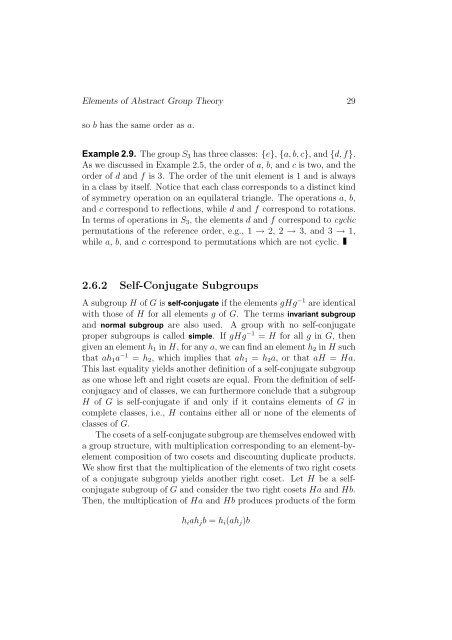Chapter 2 Elements of Abstract Group Theory
Chapter 2 Elements of Abstract Group Theory
Chapter 2 Elements of Abstract Group Theory
You also want an ePaper? Increase the reach of your titles
YUMPU automatically turns print PDFs into web optimized ePapers that Google loves.
<strong>Elements</strong> <strong>of</strong> <strong>Abstract</strong> <strong>Group</strong> <strong>Theory</strong> 29<br />
so b has the same order as a.<br />
Example 2.9. The group S3 has three classes: {e}, {a, b, c}, and {d, f}.<br />
As we discussed in Example 2.5, the order <strong>of</strong> a, b, and c is two, and the<br />
order <strong>of</strong> d and f is 3. The order <strong>of</strong> the unit element is 1 and is always<br />
in a class by itself. Notice that each class corresponds to a distinct kind<br />
<strong>of</strong> symmetry operation on an equilateral triangle. The operations a, b,<br />
and c correspond to reflections, while d and f correspond to rotations.<br />
In terms <strong>of</strong> operations in S3, the elements d and f correspond to cyclic<br />
permutations <strong>of</strong> the reference order, e.g., 1 → 2, 2 → 3, and 3 → 1,<br />
while a, b, and c correspond to permutations which are not cyclic.<br />
2.6.2 Self-Conjugate Subgroups<br />
A subgroup H <strong>of</strong> G is self-conjugate if the elements gHg −1 are identical<br />
with those <strong>of</strong> H for all elements g <strong>of</strong> G. The terms invariant subgroup<br />
and normal subgroup are also used. A group with no self-conjugate<br />
proper subgroups is called simple. If gHg −1 = H for all g in G, then<br />
given an element h1 in H, for any a, we can find an element h2 in H such<br />
that ah1a −1 = h2, which implies that ah1 = h2a, or that aH = Ha.<br />
This last equality yields another definition <strong>of</strong> a self-conjugate subgroup<br />
as one whose left and right cosets are equal. From the definition <strong>of</strong> selfconjugacy<br />
and <strong>of</strong> classes, we can furthermore conclude that a subgroup<br />
H <strong>of</strong> G is self-conjugate if and only if it contains elements <strong>of</strong> G in<br />
complete classes, i.e., H contains either all or none <strong>of</strong> the elements <strong>of</strong><br />
classes <strong>of</strong> G.<br />
The cosets <strong>of</strong> a self-conjugate subgroup are themselves endowed with<br />
a group structure, with multiplication corresponding to an element-byelement<br />
composition <strong>of</strong> two cosets and discounting duplicate products.<br />
We show first that the multiplication <strong>of</strong> the elements <strong>of</strong> two right cosets<br />
<strong>of</strong> a conjugate subgroup yields another right coset. Let H be a selfconjugate<br />
subgroup <strong>of</strong> G and consider the two right cosets Ha and Hb.<br />
Then, the multiplication <strong>of</strong> Ha and Hb produces products <strong>of</strong> the form<br />
hiahjb = hi(ahj)b













